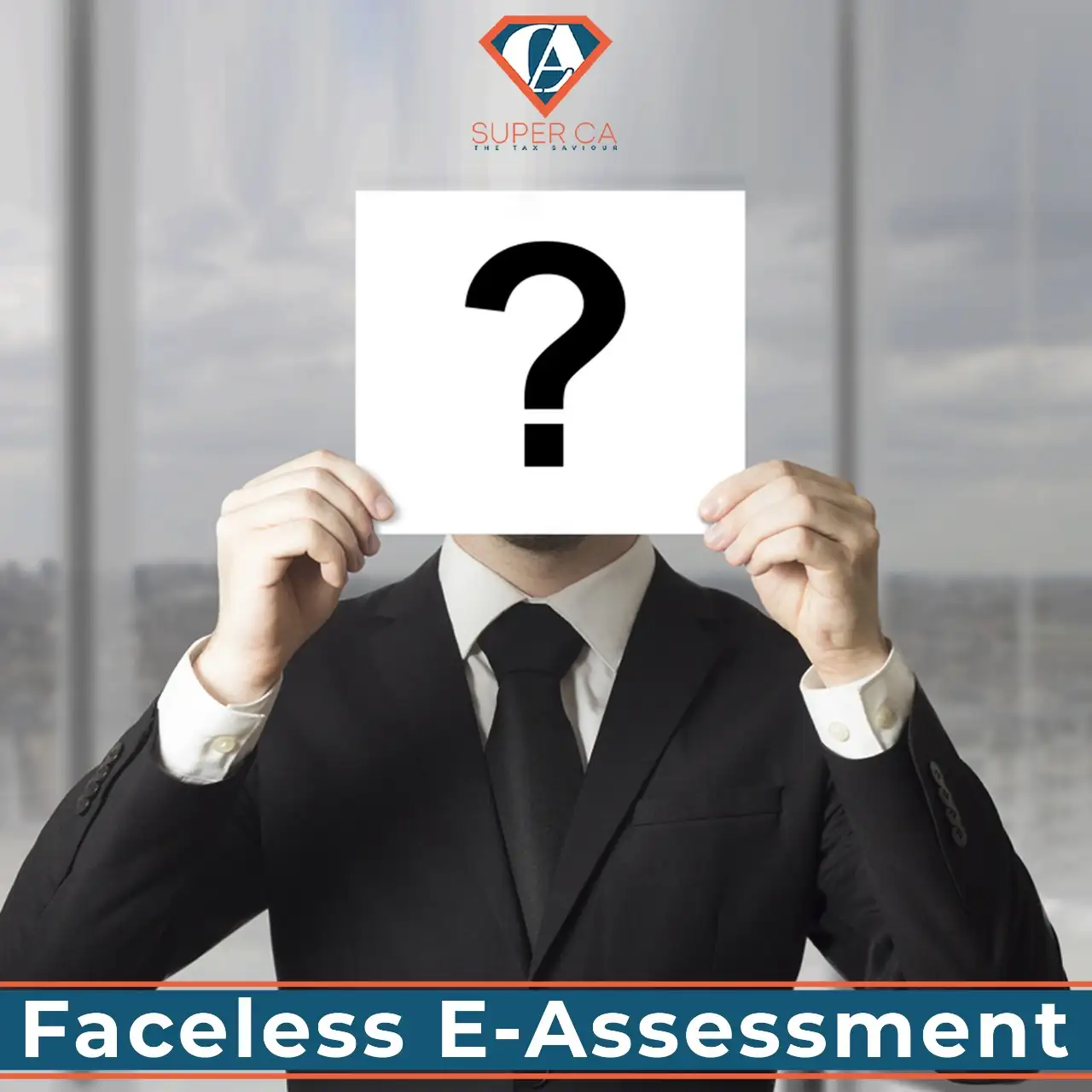Faceless E-Assessment
- Posted By SuperCA
- On 25 February

what is Faceless E-Assessment?
Faceless means that there is no need for the taxpayer to meet the tax officer and go to the income tax office. In faceless assessment, the computer will decide which tax assessment will be done by which officer. This election will be done through data analytics and AI. The allocation of cases will be automatically random. No one will know by whom the review came out from the assessment. The draft review order will be viewed in one city, reviewed in another city and finalized in the third city. The document will be the central issue of the notice with the identification number.
Apart from this, the territorial jurisdiction of assessment in the new system has also been abolished. Earlier, the tax officer of the same area used to assess where the matter was. But now the official of any state or city can investigate the matter from anywhere. The biggest advantage of this new system will be that there will not be manipulation of the Income Tax authorities to collude and create pressure. This will also prevent unnecessary litigation.
Taxpayers can reply to scrutiny notices online with dynamic jurisdiction and team based assessment. Cases will be disposed of rapidly in faceless assessment. However, some cases will not come under the purview of this new system, such as serious fraud, big tax evasion, sensitive and investigative cases, international tax cases, black money act and benami property cases.
Faceless Assessment Centres
CBDT has to set up the following units to collectively carry out E-Assessment procedures and to specify the respective jurisdiction of these units:
► National e-assessment Centre (NC) - To act as coordinator between taxpayers and different units.
► Regional e-assessment Centres (RC) - To facilitate the conduct of e-assessment proceedings in the cadre controlling region of a Principal Chief Commissioner (PCC)
► Assessment units (AU) – To make assessment by identifying points or issues, material for the determination of any liability (including refund) under the ITL, seeking information or clarification on points or issues so identified, analysis of the material furnished by the taxpayer or any other person, and such other functions;
► Verification units (VU) - Performing enquiry, cross verification, examination of books of accounts, examination of witnesses and recording of statements, and such other functions;
► Technical units (TU) - Providing technical assistance including any assistance or advice on legal, accounting, forensic, information technology, valuation, transfer pricing, data analytics, management or any other technical matter required during the assessment proceedings
► Review units (RU) – Reviewing the draft assessment order passed by the AU, if deemed necessary by NC, to ensure that relevant and material evidences, records and facts have been brought on records and duly incorporated while drafting the order, to check for arithmetical correctness of modifications proposed and such other functions.
Communication under the scheme
All communication amongst the various aforesaid units or with the taxpayer or any other person, for the purposes of making an e-assessment shall be through the NC and exclusively through electronic mode.
Generally, taxpayers shall not be required to appear in person. However, under the following two scenarios the proceedings may be conducted through the facility of video conferencing.
►In a case where a modification is proposed in the draft assessment order and the taxpayer makes a request for personal hearing.
► Any examination or recording of the statement of the taxpayer or any other person
The CBDT is responsible for setting up facilities for video-conferencing at various locations such that taxpayer or his/her authorized representative is not denied benefit of e-assessment scheme merely because taxpayer or his/her authorized representative does not access to video-conferencing facility at his/her end.
Assessment Procedure
The procedure for e-assessment is as below:
Passing of Draft Assessment Order
► NC shall serve a notice to the taxpayer making inquiry on specific issues to which taxpayer has to respond within 15 days
► On receipt of the response from the taxpayer, NC shall assign the selected cases to a specific AU in any one RC through an Automated Allocation System
► For conducting the assessment, the AU may request the NC to ;
- Obtain further information, documents or evidence from the taxpayer or any other person. NC shall issue appropriate notice or requisition to the taxpayer or any other person for obtaining such details
- To conduct enquiry or verification through VU which may be allocated to any VU through Automated Allocation System
- To seek technical assistance from the TU in which case NC shall assign the request to TU in any one RC through Automated Allocation System.
► After considering the inputs from the above process, the AU shall pass a draft assessment order either accepting taxpayer’s returned income or modifying the returned income. AU shall also recommend initiation of penalty with details of the relevant issues.
Passing of Final Assessment Order
NC shall examine draft assessment order in accordance with risk management strategy by way of an automated examination tool and thereafter NC shall either:
- Finalize the assessment as per the draft assessment order and serve a copy of such order on the taxpayer or
- Transfer the draft assessment order to RU for review in the following scenarios: a. If RU concurs with the draft assessment order, NC shall pass final assessment order or, in case of modification, provide an opportunity to the taxpayer to defend his/her case b. Alternatively, RU may make suggestions to NC for modification in the draft assessment order which shall be communicated to the AU for passing revised draft assessment order.
If modification is proposed in the draft assessment order, NC shall provide opportunity to the taxpayer for defending such modification However, If no response is received from the taxpayer, NC may pass final assessment order. If the taxpayer responds, NC shall transfer the response to AU for passing revised draft assessment order. On receipt of the revised draft assessment order, the NC may proceed as follows:
If the revised order is not prejudicial to the taxpayer – NC shall pass final assessment order
If the revised order is prejudicial to the taxpayer – an opportunity may be granted to the taxpayer before passing final assessment order
Post Assessment Process
On completion of the assessment, NC shall transfer all the electronic records of the case to the Assessing Officer having jurisdiction over such case for all other functions allocated to Assessing Officer like imposition of penalty, collection and recovery of demand, rectification of mistake, giving effect to appellate orders, submission of remand or any other report, , or any representation to be made, or any record to be produced before the Commissioner (Appeals), Appellate Tribunal or Courts, as the case may be, and proposal seeking sanction for launch of prosecution and filing of complaint before the Court.
Benefits to Taxpayers
According to the Tax Department, the faceless appeal will provide taxpayers with not only great convenience but will also ensure just and fair appeal orders and minimize any further litigation. The new system will also be instrumental in imparting greater efficiency, transparency and accountability in the functioning of the Income Tax Department
The motive behind faceless appeals is certainly noble but the implementation would be the key to ensure all steps are taken to achieve the desired objective of reducing harassment.
Also, the taxpayer should still have the comfort that he is being fully heard on his point and the authority is yet approachable, especially in sophisticated cases, which otherwise involve several hearings and representations to convince the authorities.
Conclusion
Buoyed by the success of initial steps taken for implementing e-assessment, the new e-assessment scheme is built around extensive use of latest technology including Artificial Intelligence and machine learning to remove the human elements of arbitrariness and discretion in the assessment process.
At present, the Scheme appears to be restricted to certain cases/classes to be notified by the CBDT and may not extend to other processes ordinarily involved in assessment like reference to Transfer Pricing Officer (TPO), TP assessment by TPO, reference to Dispute Resolution Panel (DRP), etc. The experience gained during the initial period of implementation of e-assessment may influence the decision to extend e-assessment to such processes also.
The e-assessment will be a learning experience for all stakeholders, including taxpayers and their authorized representatives who will need to gear up and embrace the new way of tax compliance. Since the process of assessment is spread between different units, the NC with whom the overall responsibility for conducting e-assessment lies, will need to ensure that the e-assessment is completed within the statutory timelines despite involvement of multiple units.





